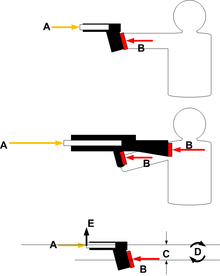- Muzzle rise
-
 Illustration of forces in muzzle rise. Projectile and propellant gases act on barrel along barrel centerline A. Forces are resisted by shooter contact with gun at grips and stock B. Height difference between barrel centerline and average point of contact is height C. Forces A and B operating over moment arm / height C create torque or moment D, which rotates the firearm's muzzle up as illustrated at E.
Illustration of forces in muzzle rise. Projectile and propellant gases act on barrel along barrel centerline A. Forces are resisted by shooter contact with gun at grips and stock B. Height difference between barrel centerline and average point of contact is height C. Forces A and B operating over moment arm / height C create torque or moment D, which rotates the firearm's muzzle up as illustrated at E.
The interchangeable terms muzzle rise, muzzle flip and muzzle climb refer to the tendency of firearms or pneumatic arms front end (muzzle end of the barrel) to rise up after firing.[1]
Muzzle climb more specifically refers to the elevation of muzzle of the firearm, caused by combined recoil from multiple shots being fired in quick succession. It has an adverse effect on accuracy of automatic and rapid-fire semi-automatic firearms, causing a target to be overshot.
The primary reason for muzzle rise is that for nearly all firearms, the centerline of the barrel is above the center of contact between the shooter and the firearms' grips and stock. The recoil forces from the bullet being fired and the propellant gases exiting the muzzle act directly down the centerline of the barrel. If that line of force is above the center of the contact points, this creates a couple, a rotational force. That couple causes the firearm to rotate, and the muzzle end to rise upwards.
Muzzle rise can be reduced by:
- adding more or more ergonomic contact points (such as a buttstock) for more grip
- reducing the vertical distance between the barrel and the contact points
- lowering recoil by using less powerful rounds
- lowering recoil by lowering the rate of fire of fully automatic firearms
- lowering recoil with devices such as muzzle brakes
- compensating for the couple using a ported barrel or asymmetric muzzle fixture
- increasing the moment of inertia, however this is unusual
- supplanting the fully automatic mode of fire with burst mode
- increasing the rate of fire of burst-fired firearms to allow the muzzle less time to rise
The Jatimatic submachine gun is an example of a firearm where the bore axis is inclined against the bolt and the rest of the firearm in order to redirect the recoil force slightly upwards. The TDI Vector submachine gun uses a more elaborate mechanical articulated mechanism which allows the block and bolt to recoil not just rearward like most other firearms, but back and then 'vectored' down off-axis along a rail system behind the weapon's magazine well to reduce muzzle rise and felt recoil.
Contents
Gallery
-
The recoil from the .500 S&W Magnum cartridge inducing significant muzzle rise during firing a Smith & Wesson Model 500 revolver.
-
The recoil from the .500 Linebaugh cartridge inducing significant muzzle rise during firing a Ruger Bisley revolver.
-
Beretta M9 semi-automatic pistol exhibiting muzzle rise just after firing a 9x19mm Parabellum cartridge.
-
An AKM assault rifle asymmetric slant cut muzzle fixture designed to counteract muzzle rise (and muzzle climb) during (automatic) firing.
-
The barrel of the Steyr LP 10 PCP air pistol has three holes drilled on top along its length to counteract muzzle rise.
See also
References
External links
Categories:- Firearm terminology
Wikimedia Foundation. 2010.






